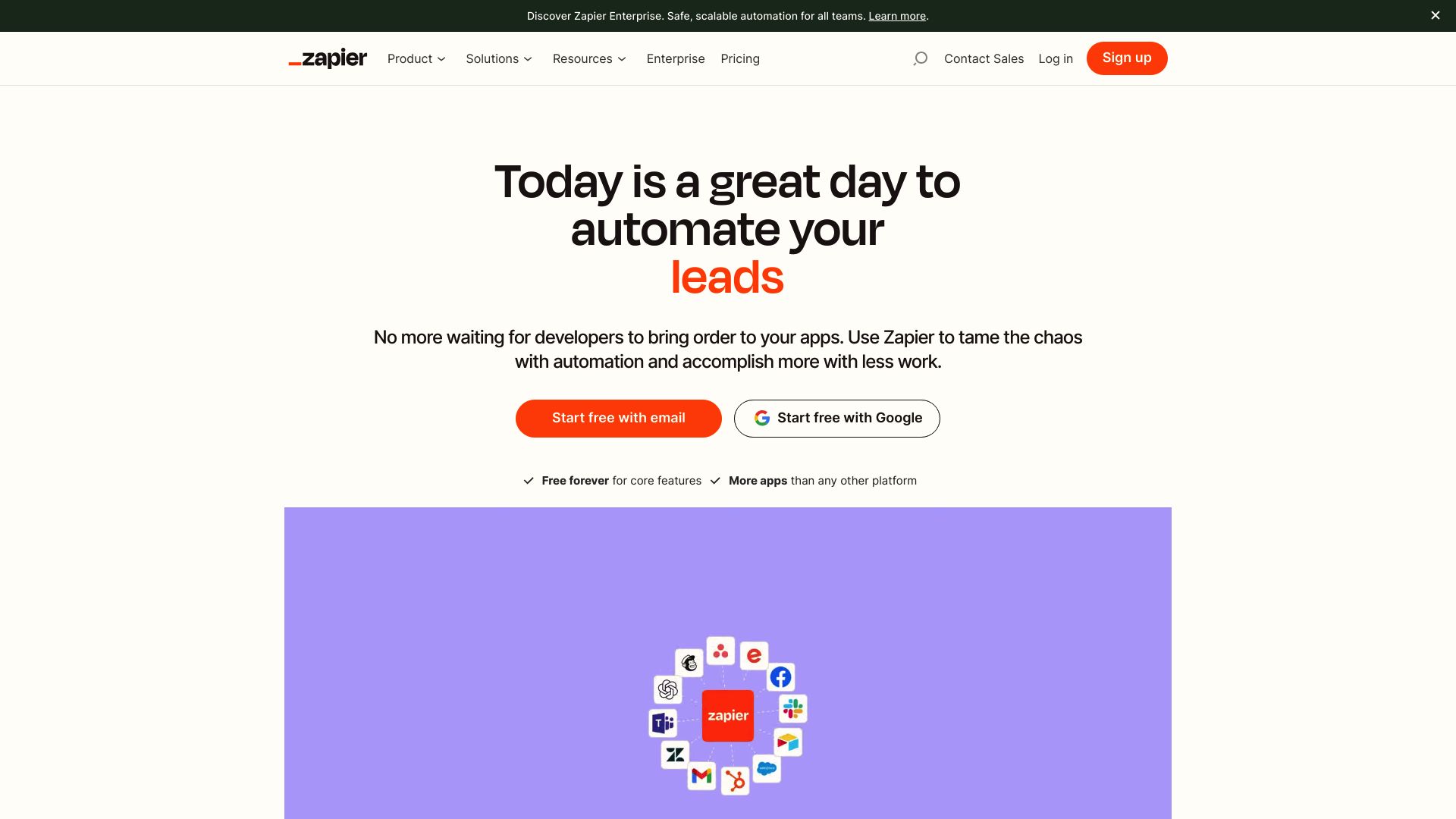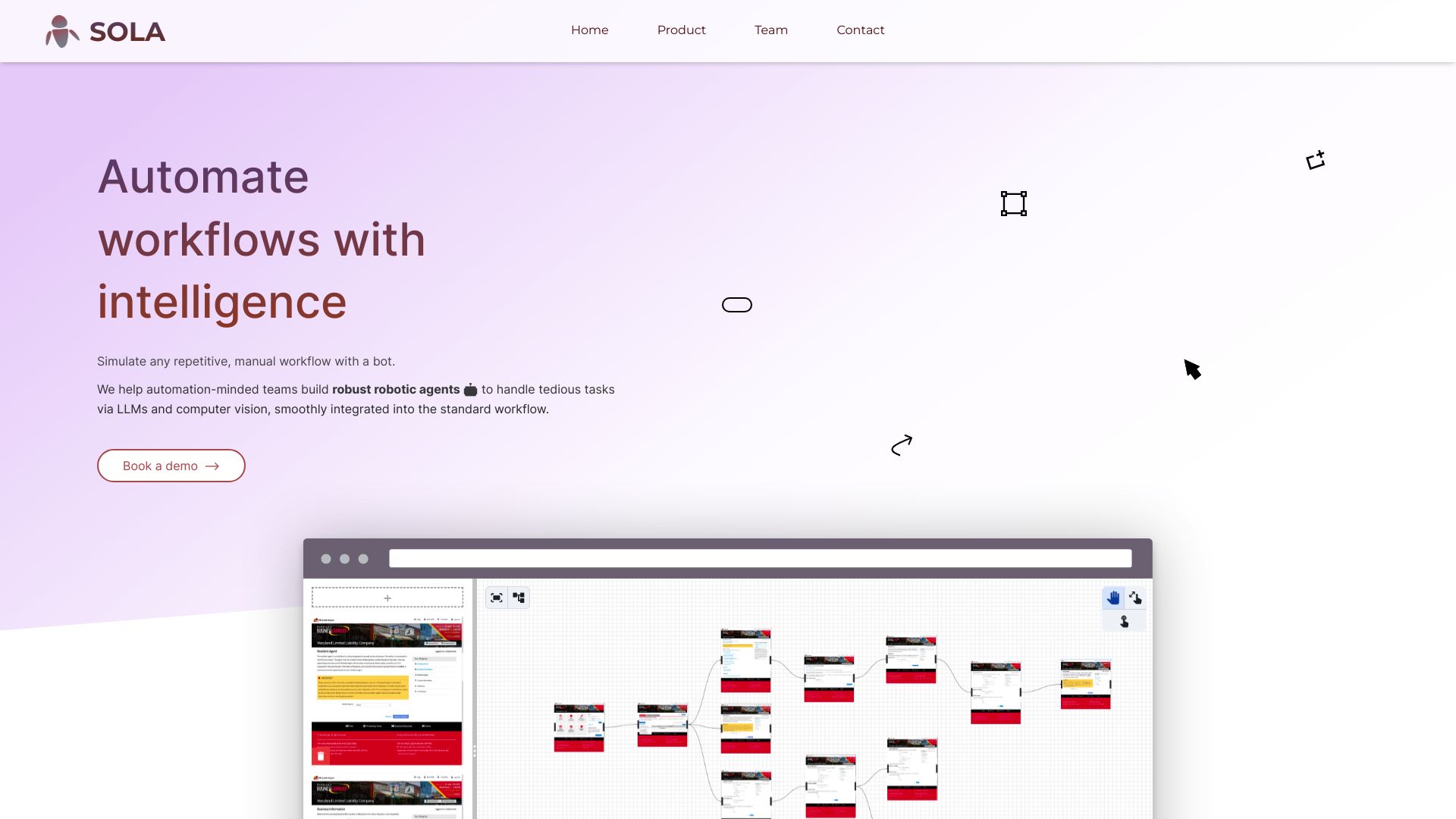Artificial intelligence continues to reshape the landscape of business automation, prompting organizations to seek powerful yet accessible solutions. This comparison delves into the capabilities of Zapier vs. Sola, and SmythOS, three platforms at the forefront of workflow automation and AI integration. We examine how each tool approaches task automation, app connectivity, and AI implementation, highlighting their strengths and limitations.
Whether you’re a developer looking for advanced AI capabilities, a business leader seeking scalable solutions, or a non-technical user in need of user-friendly automation tools, this analysis provides valuable insights to help you make an informed decision about the platform best suited to elevate your organization’s efficiency and productivity.
Zapier Overview
Zapier connects over 6000 web apps and services, enabling users to create automated workflows without coding. The platform’s visual interface simplifies integration, allowing businesses to streamline processes and boost productivity across diverse applications.

Zapier’s strength lies in its extensive library of pre-built integrations. Users can quickly set up “Zaps” — automated workflows that trigger actions across multiple apps when specific events occur. This flexibility empowers teams to automate repetitive tasks, synchronize data between systems, and create custom processes tailored to their unique needs.
Zapier’s strength lies in its extensive library of pre-built integrations… empowers teams to automate repetitive tasks, synchronize data between systems, and create custom processes tailored to their unique needs.
The platform caters to both non-technical users and developers. Its no-code visual builder allows anyone to create integrations, while advanced users can leverage JavaScript for custom logic and API handling. Zapier also provides robust tools for team collaboration, enabling organizations to work together on building and managing integrations.
While Zapier excels at app integrations, it lacks some advanced AI capabilities. The platform doesn’t offer features like hosted AI agents, memory and context retention, or multimodal interactions. For businesses primarily focused on connecting existing web services and automating workflows, these limitations may not be significant drawbacks.
Zapier’s scalability, extensive app ecosystem, and user-friendly interface make it a powerful tool for businesses looking to enhance productivity through automation. However, organizations seeking more advanced AI-driven solutions or autonomous agent capabilities may need to explore alternative platforms to fully meet their needs.
Sola Overview
Sola revolutionizes workflow automation with its AI-powered platform. Designed to streamline repetitive tasks, Sola harnesses the power of Large Language Models and computer vision to boost business efficiency across various sectors.

Sola’s core offering centers on creating intelligent bots capable of automating complex processes like data entry, scraping, and filing. The platform’s Workflow Recorder captures on-screen processes, while the Annotation Editor allows users to label and outline workflow steps. These components feed into the Bot Builder, which transforms annotated workflows into AI-powered automation.
Sola’s core offering centers on creating intelligent bots capable of automating complex processes like data entry, scraping, and filing.
Integration capabilities stand out as a key strength of Sola. The platform works seamlessly with major browsers, desktop applications, and popular software, eliminating the need for complex integrations. This versatility makes Sola an attractive option for businesses looking to implement automation without overhauling their existing tech stack.
While Sola offers impressive automation capabilities, it lacks some advanced features found in more comprehensive AI agent builders. The platform doesn’t provide hosted agents for development or production environments, and there’s no mention of autonomous agents or multi-agent collaboration. These limitations may impact users seeking more advanced AI functionalities or extensive customization options.
Despite these constraints, Sola excels in user-friendliness and practical application. Its intuitive interface allows users to create bots from screen recordings in minutes, making it accessible to both technical and non-technical users. The platform’s adaptive learning capability enables bots to incorporate new logic automatically, enhancing their effectiveness over time.
Sola excels in user-friendliness and practical application. Its intuitive interface allows users to create bots from screen recordings in minutes…
Sola’s focus on specific industries like legal, finance, insurance, and healthcare demonstrates its commitment to addressing real-world business challenges. By automating tasks such as incorporation filings, invoice processing, claims management, and compliance reporting, Sola delivers tangible value to its target markets.
Feature Comparison
Zapier and Sola take different approaches to workflow automation, with distinct strengths and limitations. Zapier excels in connecting web applications through its extensive library of pre-built integrations, while Sola focuses on AI-powered automation of complex on-screen processes.
Zapier’s visual builder and no-code interface make it accessible to non-technical users, allowing quick creation of automated workflows between apps. However, Zapier lacks advanced AI capabilities like hosted agents, memory and context retention, or multimodal interactions. Its strength lies in app integrations rather than intelligent automation.
In contrast, Sola leverages AI and computer vision to automate complex tasks like data entry and scraping. Its Workflow Recorder and Annotation Editor enable users to create intelligent bots from screen recordings. While powerful for specific use cases, Sola doesn’t offer the breadth of app integrations that Zapier provides. Additionally, Sola lacks features like hosted agents, autonomous agents, or multi-agent collaboration found in more comprehensive AI platforms.
Feature Comparison Table
| Zapier | Sola | SmythOS | |
|---|---|---|---|
| CORE FEATURES | |||
| AI Agents | ❌ | ✅ | ✅ |
| Hosted Agents (Dev, Production) | ❌ | ❌ | ✅ |
| Memory & Context | ❌ | ✅ | ✅ |
| Autonomous Agents | ❌ | ✅ | ✅ |
| Explainability & Transparency | ❌ | ✅ | ✅ |
| Debug Tools | ✅ | ❌ | ✅ |
| Multimodal | ❌ | ❌ | ✅ |
| Problem-Solving Capabilities | ❌ | ✅ | ✅ |
| Multi-Agent Collaboration | ❌ | ❌ | ✅ |
| Human-AI Interaction | ❌ | ✅ | ✅ |
| Work as Team | ✅ | ❌ | ✅ |
| Agent Work Scheduler | ❌ | ✅ | ✅ |
| SECURITY | |||
| Constrained Alignment | ❌ | ❌ | ✅ |
| IP Control | ❌ | ❌ | ✅ |
| COMPONENTS | |||
| Foundation AIs | ❌ | ✅ | ✅ |
| Huggingface AIs | ❌ | ❌ | ✅ |
| Zapier APIs | ✅ | ❌ | ✅ |
| Classifiers | ❌ | ❌ | ✅ |
| Logic | ❌ | ✅ | ✅ |
| Data Lakes | ❌ | ❌ | ✅ |
| DEPLOYMENT OPTIONS (EMBODIMENTS) | |||
| Staging Domains | ✅ | ❌ | ✅ |
| Production Domains | ✅ | ❌ | ✅ |
| Deploy as Site Chat | ❌ | ✅ | ✅ |
| Deploy as Scheduled Agent | ❌ | ✅ | ✅ |
| Deploy as GPT | ❌ | ❌ | ✅ |
| DATA LAKE SUPPORT | |||
| Hosted Vector Database | ❌ | ❌ | ✅ |
| Sitemap Crawler | ❌ | ❌ | ✅ |
| YouTube Transcript Crawler | ❌ | ❌ | ✅ |
| URL Crawler | ❌ | ✅ | ✅ |
| PDF Support | ❌ | ✅ | ✅ |
| Word File Support | ❌ | ✅ | ✅ |
| TXT File Support | ❌ | ✅ | ✅ |
Best Alternative to Zapier and Sola
SmythOS stands out as the superior alternative to Zapier and Sola for AI-powered workflow automation. Our platform combines the strengths of both competitors while offering advanced capabilities that take automation to the next level.
We provide a comprehensive suite of AI agent creation and deployment tools that surpass the limitations of Zapier’s app integrations and Sola’s screen recording approach. SmythOS empowers users to build sophisticated, autonomous AI agents capable of handling complex tasks across multiple domains.
SmythOS empowers users to build sophisticated, autonomous AI agents capable of handling complex tasks across multiple domains.
Unlike Zapier’s focus on connecting web apps or Sola’s emphasis on automating on-screen processes, SmythOS offers unparalleled flexibility. Our visual builder allows users to create AI workflows that seamlessly integrate with APIs, databases, and AI models from various providers. This versatility enables automation of virtually any business process or workflow.
SmythOS excels in its ease of use while delivering enterprise-grade features. Our drag-and-drop interface makes agent creation accessible to non-developers, while advanced users can leverage our extensive customization options. We support multimodal interactions, autonomous problem-solving, and multi-agent collaboration — capabilities absent in both Zapier and Sola.
By choosing SmythOS, users gain access to a future-proof platform designed for scalability and innovation. Our commitment to ethical AI practices, robust security features, and continuous development ensures that SmythOS remains at the forefront of AI automation technology. For businesses seeking a truly intelligent and adaptable automation solution, SmythOS is the clear choice over Zapier and Sola.
Conclusion
Zapier, Sola, and SmythOS each offer unique approaches to workflow automation and AI integration. Zapier excels in connecting web applications through its vast library of pre-built integrations, making it ideal for businesses primarily focused on linking existing services. Sola leverages AI and computer vision to automate complex on-screen processes, particularly useful for industries like legal, finance, and healthcare.
However, SmythOS emerges as the superior choice for businesses seeking comprehensive AI-powered automation. Our platform combines the best of both worlds — extensive integrations and advanced AI capabilities — while offering unparalleled flexibility and scalability. SmythOS’s drag-and-drop interface allows for rapid development of sophisticated AI agents, capable of handling complex tasks across multiple domains.
Unlike Zapier and Sola, SmythOS provides hosted agents for both development and production environments, enabling seamless deployment and scaling. Our platform supports multimodal interactions, problem-solving capabilities, and multi-agent collaboration, features not found in Zapier or Sola. This makes SmythOS ideal for businesses looking to push the boundaries of AI automation and create truly intelligent, adaptive workflows.
If you’re ready to unlock the full potential of AI for your business, explore our diverse range of AI-powered agent templates to jumpstart your journey. For a hands-on experience with the platform that’s revolutionizing AI automation, create a free SmythOS account and start building your own AI agents today. Join the AI revolution with SmythOS and transform the way your business operates.